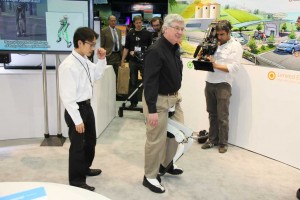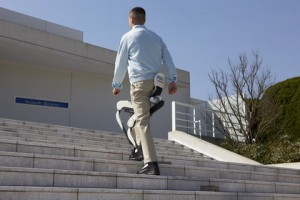
This ingenious machine helps people with weakened leg muscles by supporting up to 20 pounds. It is currently being tested in Japan.
“Computerized electric crutches” is one way to describe the latest innovation emerging from Honda’s research and development operation. That’s what I was thinking as I fumbled my way up and down stairs and around the SAE World Congress exhibition floor while wearing or riding a “Bodyweight Support Assist.”
BSA was designed to help people with weakened leg muscles. Once I stopped looking down at the saddle and tried to walk and crouch as I normally would, I got in better sync with the machine that supports up to 20 pounds of the user’s weight.
BWA reduces the load on the user’s legs while walking, going up and down stairs, and while standing in a semi-crouching position. The load on leg muscles and joints (in the hip, knees, and ankles) is reduced. This device has a simple structure consisting of seat, frame, and shoes, and the user can put it on by simply wearing the shoes and lifting the seat into position. It is currently being used by workers inspecting Odyssey minivans at the Saitama, Japan, factory.
BWA weights about 14.3 pounds, including shoes of 1.5 pounds, and 2.6 pounds of lithium ion batteries. A charge lasts about two hours. At the moment BWA supports about 6.6 – 20 pounds of bodyweight. The amount of assistance is automatically adjusted depending on the flexion angle of one’s knees.
The somewhat unnatural walking motion I experienced is achieved by changing the amount of force applied to the right and left legs through the control of two motors based on the information obtained though sensors imbedded in the shoes. The user simply needs to wear the shoes and lift the seat into place. BWA supports a portion of your bodyweight by lifting the seat as the frame between the shoe and seat bends and extends, just like knees, with the force from the motor. As a result, the load on leg muscles and joints (in the hip, knees, and ankles) is reduced.

Stride Management Assist, is also lightweight, wearable machine designed for people with weakened leg muscles, but who can still walk on their own.
The other machine on display, Stride Management Assist, is also lightweight, wearable machine designed for people with weakened leg muscles, but who can still walk on their own. SMA monitors a user’s walking motions from hip angle sensors. Based on the information, a computer applies “cooperative control” and calculates the amount and timing of motorized assistance to be provided. With SMA, the user’s stride is lengthened compared to their normal stride and the walking pace regulated, thereby making it easier to walk, according to Honda.
SMA is equipped with thin brushless motors and a control computer. It is worn around the waist and thigh. The sensors/motors, located on the sides of the hip joint area, measure information about the user’s walking motions. The torque generated by the motors is transmitted to the thighs through the frames to control factors such as the length of the user’s stride and to offer optimal walking assist. It’s light — at about 6 pounds — for a medium size version. Large and small versions are also under development. A battery charge lasts about two hours.
Neither of these clever machines is a prosthetic, since they do not replace body parts, but rather they are supplemental aids to walking that could have wide commercial applications in medical, industrial and freight sectors, to name just a few, since both can be helpful during physically demanding activities.
It’s walking proof of serendipity that can come from advanced research. Originally intended to support walking for the elderly or people with weakened leg muscles, the devices are currently being tested in real-world conditions to evaluate their effectiveness. The company has applied for more than 130 patents for the devices.
The control technology regulating these devices is a unique Honda innovation, that it says came about from the cumulative study of human walking that started in 1999 with its humanoid robot, ASIMO.
Honda says it has no plans at this time to make the walking assist machines commercially available. They are experimental devices that are “still in a research phase and we are in the process of validating the technology.”
Video is available at Honda’s YouTube Channel.
.

Can you lose your balance and fall over?
P.S. I like the photos in all the stories.
Balance is provided by you, not the assist devices, but since they are basically working through your center of gravity just below your waistline, they do not do anything that interferes with balance. The devices just supplements muscle strength.